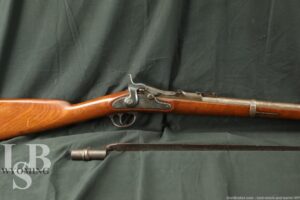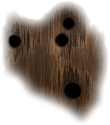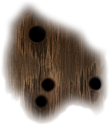
U.S. Springfield Trapdoor Cadet 1863/1870 Conversion In .50-70, Antique
SOLD FOR: $740.00
WOA#: WY240402SA004
Make: United States Armory and Arsenal at Springfield
Model: Model 1863/1870 Conversion
Serial Number: 1755
Year of Manufacture: 1871
Caliber: .50-70 (Black powder)
Action Type: Trapdoor, single shot
Markings: The left side of the barrel and receiver are marked, “1755” The top of the tradoor is marked, “1870 / US” The lock plate is marked, “1863 / U.S. SPRINGFIELD” The barrel bands are marked, “U”
Barrel Length: 30”
Sights / Optics: The front sight is a one-piece blade and barrel mounted base. The rear sight is a flip up sliding ladder sight with a V-notch.
Stock Configuration & Condition: The wood stock has a endcap with two barrel bands, two through bolts, straight wrist, straight comb, with a steel semi-crescent buttplate. The stock has been refinished. There are scratches, scuffs, pressure dents, and finish loss throughout. The LOP measures 13.25” from the front of the trigger to the back of the buttplate. The stock rates in about Very Good overall condition for an antique.
Type of Finish: Blued.
Finish Originality: Original
Bore Condition: The bore is Very Bright and the rifling is sharp. There is no erosion or pitting in the bore. In this writer’s opinion, this bore rates 9.5/10.
Most antique firearms have bores that will show erosion. This is not only due to age but to the use of black powder. When fired, black powder reacts corrosively. NRA Antique Firearm Conditions Standards are quite lenient for bores. In some cases, the NRA standards disregarded the bore’s condition for collectors’ firearms.
Overall Condition: This rifle retains about 40% of its metal finish. The action and trigger guard retain most of their bluing. There is finish wear and patina on teh action and trigger guard. The barrel and barrel bands are worn of finish and the remaining finish has gone to patina. The screw heads show light use. Overall, this rifle rates in about Good condition as an antique. The bayonet is completely rusted and has heavy pitting.
Mechanics: The action functions correctly. The rifle has a half-cock safety. We did not fire this rifle. As with all used firearms, a thorough cleaning may be necessary to meet your maintenance requirements.
Box, Paperwork & Accessories: Bayonet.
Our Assessment: The U.S. Springfield Trapdoor Cadet 1863/1870 Conversion in .50-70 is a fascinating firearm that illustrates the transitional period in American military rifle development following the Civil War. This rifle represents an effort by the U.S. Army to update and repurpose existing muzzleloading rifles into more modern breechloading firearms, reflecting the rapid technological advancements in firearms during that era. The original Springfield Model 1863 was a muzzleloading rifle used extensively during the Civil War. It was a percussion cap rifle, loaded from the muzzle end with powder and ball, and was reliable but slow to load and fire. After the Civil War, the U.S. Army sought to modernize its arsenal without incurring the high costs of manufacturing entirely new firearms. The solution was to convert existing muzzleloaders into breechloaders, leading to the development of the “Trapdoor” mechanism. The Trapdoor mechanism, designed by Erskine S. Allin, was a significant innovation. It involved cutting away part of the barrel and fitting a hinged breechblock, or “trapdoor,” that could be opened to load a metallic cartridge. This conversion allowed for much faster loading and firing compared to the old muzzleloading system. The Springfield Model 1863 rifles were converted in this manner to create the Springfield Model 1866, which used a .50-70 Government cartridge. The .50-70 Government cartridge was a significant step forward in ammunition technology. It was a centerfire cartridge with a brass case, which improved reliability and ease of handling compared to the paper cartridges used in muzzleloaders. The .50-70 cartridge had a 450-grain bullet and was capable of decent accuracy and stopping power, making it suitable for military use. The Springfield Trapdoor Cadet 1863/1870 Conversion was a specialized variant designed for use by cadets at military academies. These cadet rifles were typically shorter and lighter than the standard infantry models, making them more manageable for younger and less experienced users. The conversions were done at the Springfield Armory and involved modifying surplus Model 1863 rifles to accept the new Trapdoor breechblock and chamber the .50-70 cartridge. The Springfield Trapdoor Cadet rifles saw extensive use in military academies and training facilities throughout the latter half of the 19th century. They provided a valuable training tool for cadets, who could learn the fundamentals of marksmanship and rifle handling with a weapon that was similar in operation to the standard issue arms of the time. -R.E.



